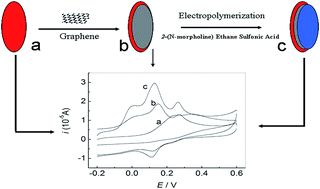Simultaneous voltammetric detection of dopamine, ascorbic acid and uric acid using a poly(2-(N-morpholine)ethane sulfonic acid)/RGO modified electrode
Abstract
A poly(2-(N-morpholine) ethane sulfonic acid)/reduced graphene oxide (RGO) modified glassy carbon electrode (GCE) was prepared using an electropolymerization method, and was characterized by scanning electron microscopy (SEM) and electrochemical impedance spectroscopy (EIS). The electrochemical behaviors and simultaneous detection of ascorbic acid (AA), dopamine (DA) and uric acid (UA) at this electrode were studied by cyclic voltammetry (CV) and differential pulse voltammetry (DPV). Tests showed that this electrode exhibited excellent electrocatalytic activity towards the oxidation of AA, DA and UA. The oxidation peak currents of AA, DA and UA were proportional with their concentrations in the ranges 1.0 μM–30 μM (30 μM–100 μM), 0.05 μM–100 μM and 0.1 μM–100 μM, with detection limits of 0.43 μM, 0.0062 μM and 0.056 μM, respectively. In addition, this electrode exhibited an excellent selectivity, reproducibility and stability, and has been successfully used to determine real samples with satisfactory results.



 Please wait while we load your content...
Please wait while we load your content...